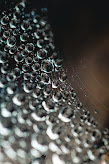Why small drops of mercury form spherical bead instead of spreading on the surface. Why do particles of soil at the bottom of river remain separated but they stick together when taken out ? Why does a liquid rise (or fall) in a thin capillary as soon as the capillary touches the surface of the liquid ?
All these phenomena are caused due to the characteristic property of liquids called surface tension. A molecule in the bulk of liquid experiences equal intermolecular forces from all sides. The molecule, therefore does not experience any net force. But for the molecule on the surface of liquid, net attractive force is towards the interior of the liquid due to the molecules below it. Since there are no molecules above it. Liquids tend to minimize their surface area. The molecules on the surface experience a net downward force and have more energy than the molecules in the bulk, which do not experience any net force. Therefore, liquids tend to have minimum number of molecules at their surface. If surface of the liquid is increased by pulling a molecule from the bulk, attractive forces will have to be overcome. This will require expenditure of energy.
